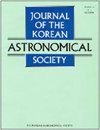Massive Structures of Galaxies at High Redshifts in the Great Observatories Origins Deep Survey Fields
IF 0.8
4区 物理与天体物理
Q3 ASTRONOMY & ASTROPHYSICS
引用次数: 9
Abstract
If the Universe is dominated by cold dark matter and dark energy as in the currently popular ΛCDM cosmology, it is expected that large scale structures form gradually, with galaxy clusters of mass M ? 10 14 M ⊙ appearing at around 6 Gyrs after the Big Bang (z ∼ 1). Here, we report the discovery of 59 massive structures of galaxies with masses greater than a few times 10 13 M ⊙ at redshifts between z = 0.6 and 4.5 in the Great Observatories Origins Deep Survey fields. The massive structures are identified by running top-hat filters on the two dimensional spatial distribution of magnitude-limited samples of galaxies using a combination of spectroscopic and photometric redshifts. We analyze the Millennium simulation data in a similar way to the analysis of the observational data in order to test the _CDM cosmology. We find that there are too many massive structures (M > 7×1013M ⊙ ) observed at z > 2 in comparison with the simulation predictions by a factor of a few, giving a probability of < 1/2500 of the observed data being consistent with the simulation. Our result suggests that massive structures have emerged early, but the reason for the discrepancy with the simulation is unclear. It could be due to the limitation of the simulation such as the lack of key, unrecognized ingredients (strong non-Gaussianity or other baryonic physics), or simply a difficulty in the halo mass estimation from observation, or a fundamental problem of the ΛCDM cosmology. On the other hand, the over-abundance of massive structures at high redshifts does not favor heavy neutrino mass of ∼ 0.3 eV or larger, as heavy neutrinos make the discrepancy between the observation and the simulation more pronounced by a factor of 3 or more.大天文台起源深巡天域中高红移星系的大质量结构
如果宇宙像目前流行的ΛCDM宇宙学那样由冷暗物质和暗能量主导,那么预计大尺度结构将逐渐形成,质量为M ?10 14 M⊙出现在大爆炸后约6 Gyrs (z ~ 1)。在这里,我们报告了在大天文台起源深度调查领域中发现的59个质量大于10 13 M⊙几倍的大质量星系结构,其红移在z = 0.6和4.5之间。大质量结构是通过使用光谱和光度红移相结合的方法,对星等有限的星系样本的二维空间分布运行顶帽过滤器来识别的。为了验证_CDM宇宙论,我们采用与观测数据分析类似的方法来分析千禧年模拟数据。我们发现,在z > 2观测到的大质量结构(M > 7×1013M⊙)与模拟预测相比,有几个因子,给出了< 1/2500的观测数据与模拟一致的概率。我们的结果表明,巨大的结构已经很早就出现了,但与模拟结果不一致的原因尚不清楚。这可能是由于模拟的局限性,例如缺乏关键的、未被识别的成分(强非高斯性或其他重子物理),或者仅仅是观测晕质量估计的困难,或者是ΛCDM宇宙学的基本问题。另一方面,高红移的大质量结构的过剩不利于质量为~ 0.3 eV或更大的重中微子,因为重中微子使观测和模拟之间的差异更加明显,达到3倍或更多。
本文章由计算机程序翻译,如有差异,请以英文原文为准。
求助全文
约1分钟内获得全文
求助全文
来源期刊

Journal of the Korean Astronomical Society
地学天文-天文与天体物理
CiteScore
1.30
自引率
10.00%
发文量
0
审稿时长
>12 weeks
期刊介绍:
JKAS is an international scientific journal publishing papers in all fields of astronomy and astrophysics. All manuscripts are subject to the scrutiny of referees. Manuscripts submitted to JKAS must comply with the ethics policy of JKAS. Six regular issues are published each year on February 28, April 30, June 30, August 31, October 31, and December 31. One year''s issues compose one volume.
 求助内容:
求助内容: 应助结果提醒方式:
应助结果提醒方式:


